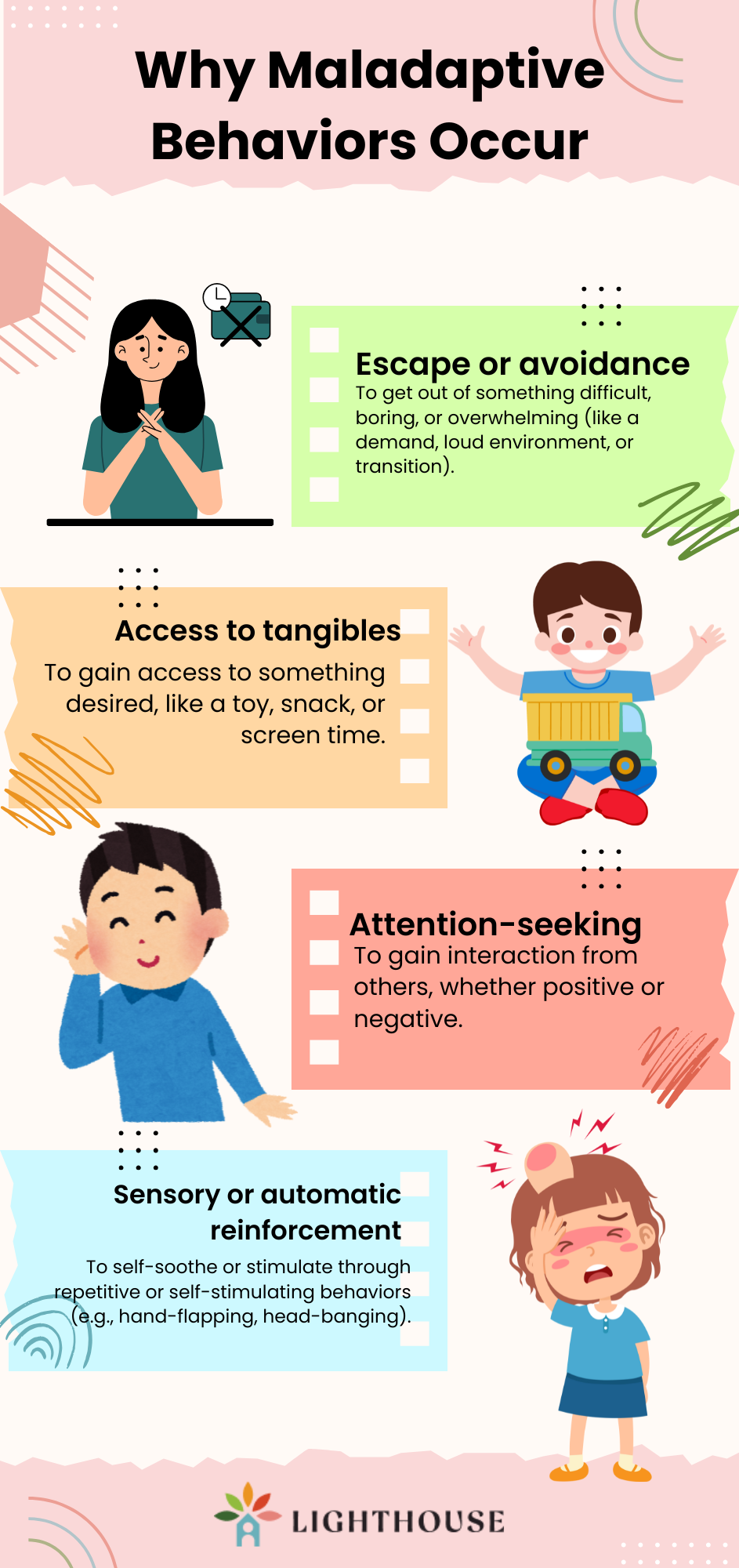Key Points:
- Maladaptive behaviors are actions that interfere with learning, relationships, or daily functioning and are addressed through individualized ABA interventions.
- These behaviors can serve various functions, such as escaping demands, seeking attention, or self-soothing through sensory input.
- Understanding common types—like aggression, self-injury, or elopement—helps parents work with behavior teams to create effective strategies.
When most people think of therapy, they picture calm conversations and supportive environments. But in the world of Applied Behavior Analysis (ABA), therapy often begins with behaviors that are far from calm—hitting, screaming, bolting out of rooms, or shutting down completely. These aren’t just “bad behaviors”; they’re what we call maladaptive behaviors, and they serve a purpose.
A list of maladaptive behaviors in ABA isn’t just for professionals. For parents, it’s a roadmap for understanding why certain behaviors happen and how they can be addressed. These behaviors aren’t random—they’re communication. They’re the child’s way of saying, “I’m overwhelmed,” “I don’t want to do this,” or “This makes me feel better.”
Let’s dig into what these behaviors look like, why they happen, and how understanding them can open the door to real progress.
What Are Maladaptive Behaviors in ABA?
Before we dive into specifics, it helps to know what we’re really talking about.
Maladaptive behaviors are actions or responses that interfere with a person’s ability to learn, connect with others, or navigate everyday life. They may pose a safety risk, lead to exclusion from group settings, or prevent meaningful participation in school or family routines.
In ABA therapy, identifying and understanding maladaptive behaviors is often the first step toward meaningful change. That’s why creating a comprehensive list of maladaptive behaviors in ABA is so important—it allows us to assess the function behind the behavior and plan effective interventions.
Some behaviors are more obvious—like aggression or screaming. Others might look more subtle, like avoidance, repetition, or shutting down completely. But they all deserve attention, compassion, and support.
Why Maladaptive Behaviors Occur
Behavior doesn’t exist in a vacuum. It’s shaped by context, history, and the environment.
In ABA, we often ask: What function does this behavior serve?
Here are the most common reasons a child might engage in a maladaptive behavior:
 When we understand the “why” behind the behavior, we can begin to replace it with something safer and more functional.
When we understand the “why” behind the behavior, we can begin to replace it with something safer and more functional.
Common Maladaptive Behaviors in ABA Therapy
Maladaptive behaviors vary from child to child, but there are patterns ABA therapists often encounter. The behaviors below are among the most common seen in therapy, classrooms, and home environments.
Let’s explore them one by one.
 1. Aggression
1. Aggression
This includes hitting, kicking, biting, scratching, throwing objects, or pushing others. Aggression is often a response to feeling overwhelmed, unsafe, or unable to communicate a need.
Aggression may also serve as a way to escape tasks or demand attention. For example, a child who hits a sibling when asked to clean up may be trying to avoid the task—or may simply not know how to ask for help or express frustration.
ABA therapists work on identifying the triggers and teaching alternative communication strategies or coping skills.
2. Self-Injurious Behavior (SIB)
This can include head-banging, hand-biting, scratching oneself, or hitting one’s own body. SIB can be especially concerning because of the safety risk involved.
Sometimes, self-injury is sensory-related—it may provide a sense of relief or stimulation. Other times, it may be a response to demands, discomfort, or emotional overwhelm.
A detailed functional behavior assessment (FBA) is key here to uncover the motivation behind the behavior and create a safer replacement behavior.
3. Elopement
Elopement refers to leaving an area without permission or supervision. This could mean bolting out of a classroom, wandering from home, or running away in a public place.
It’s not just inconvenient—it can be dangerous.
Often, elopement is a way for children to escape overwhelming environments or demands. In other cases, it might be driven by curiosity or a desire to go somewhere they prefer.
ABA programs often incorporate safety skills, such as learning to stop on command, respond to one’s name, or ask for a break.
 4. Tantrums and Emotional Outbursts
4. Tantrums and Emotional Outbursts
Crying, yelling, falling to the floor, or throwing items during a meltdown are often signals of unmet needs or emotional dysregulation.
These episodes can be linked to changes in routine, task refusal, sensory overload, or difficulty transitioning.
ABA therapists may teach emotional regulation skills, calming strategies, and communication tools like using visuals or words to express needs.
5. Noncompliance or Task Refusal
When a child repeatedly refuses to follow instructions or complete tasks, it can be seen as defiance—but in ABA, we look deeper.
This behavior often reflects avoidance. Maybe the task is too hard, unfamiliar, or feels unpleasant. Maybe the child hasn’t yet built the motivation to complete it.
ABA therapy focuses on breaking tasks into manageable steps, using positive reinforcement, and teaching self-advocacy.
6. Repetitive or Stereotypic Behaviors
Sometimes called “stimming,” these behaviors include flapping, spinning, repeating sounds or phrases, or rocking. Not all repetitive behaviors are maladaptive—many are harmless and help with self-regulation.
But if the behavior interferes with learning, social interaction, or safety, it may need to be addressed.
ABA therapy works to understand the purpose of the behavior and may introduce alternative activities that serve the same function without causing disruption.
Behavioral Patterns to Watch For: A Parent’s Checklist
For parents, recognizing patterns in behavior can make a big difference. The list below outlines some common maladaptive behaviors seen in children receiving ABA services. Each of these may require specific attention, support, and intervention planning.
Top 10 Maladaptive Behaviors Often Addressed in ABA:
- Physical Aggression
Includes hitting, biting, kicking, or pushing others. May be triggered by frustration, attention-seeking, or sensory discomfort.
- Verbal Aggression
Includes yelling, name-calling, threats, or insults. Often serves to gain attention or avoid undesired tasks. - Self-Injurious Behavior (SIB)
Includes actions like head-banging, skin-picking, or biting oneself. Can be sensory-seeking, emotionally driven, or automatic. - Property Destruction
Breaking toys, tearing materials, or throwing furniture. May be a response to environmental stress or difficulty transitioning. - Tantrums/Meltdowns
Screaming, crying, or falling to the floor. Usually a sign of unmet needs, emotional overload, or limited coping strategies. - Elopement
Running off or leaving an assigned area. Often tied to escape from demands or access to preferred places. - Noncompliance
Refusing instructions or delaying tasks. May reflect avoidance, autonomy-seeking, or difficulty understanding the expectation. - Inappropriate Vocalizations
Repetitive noises, loud outbursts, or scripting during quiet times. May serve as sensory input or attention-seeking. - Socially Inappropriate Behavior
Interrupting, touching others inappropriately, or personal space issues. Could stem from lack of social awareness or impulsivity. - Obsessive or Rigid Behavior
Insisting on sameness, getting stuck on topics, or reacting strongly to changes in routine. May indicate anxiety or need for predictability.
Each of these behaviors can be supported through personalized interventions, patience, and consistency.
 Supporting Positive Change Through ABA
Supporting Positive Change Through ABA
Understanding maladaptive behaviors doesn’t mean accepting them as permanent. On the contrary, behavior is changeable—especially when we identify its purpose and teach meaningful alternatives.
In ABA therapy, goals are built around reducing harmful or interfering behaviors while increasing skills like communication, flexibility, social engagement, and self-regulation.
Progress may not always be linear. But with collaboration between families and therapists, even long-standing behaviors can be replaced with safer, more functional ones.
Ready to Take the Next Step?
If you’ve read through this list of maladaptive behaviors in ABA and recognized some of them in your child, know that you’re not alone—and support is available.
Lighthouse ABA offers compassionate, evidence-based ABA therapy in New York City and North Carolina. Our approach focuses on understanding the why behind each behavior, so we can build meaningful, lasting change.
Let’s work together to turn confusion into clarity—and replace challenging behaviors with progress and connection. Schedule a consultation today!


